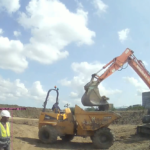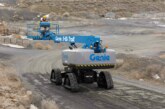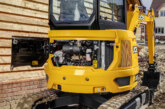Richard Lane, Commercial Director, VisionTrack explains how video telematics is transforming plant safety
Video telematics is all about visibility, using cameras to gain a 360-view around plant to drive safety improvements and compliance. Whether making equipment easier and safer to manoeuvre or providing construction companies with a comprehensive picture of how equipment is being operated, the technology is helping to reduce collisions and protect vulnerable people.
On average, seven workers die each year after collisions involving vehicles or plant on construction sites in the UK, while 93 more are seriously injured. On top of this there are also those incidents involving vulnerable people that occur on the road network or at the entrance of a site.
Advanced driving aid
A combination of cameras and sensors gives the driver a complete view around the plant via an in-cab monitor. Front, side and rear cameras ensure equipment is covered from all angles, while corner, side and rear sensors warn of nearby people – such as workers, pedestrians or cyclist – especially in blind spots. The system can also be linked to specific driving manoeuvres, so a driver can view the appropriate camera when, for example, the left-hand indicator or reverse gear is engaged.
Moving forward, AI is going to play a far greater role in video telematics and become increasingly embedded in camera hardware. The latest intelligent detection cameras adopt deep learning technology to provide real-time insight. They can identify and track vulnerable people, making it possible to trigger an alert to the driver – and even activate an external, audible alarm – when someone enters virtual exclusion zones around the plant.
With traditional proximity sensors, alerts can be triggered by inanimate objects, so there is a risk that drivers become complacent and takes less notice of an alarm because of false positives. The AI-powered detection camera can locate people up to 20 metres away in real-time, establishing the severity of risk dependent on their proximity to the equipment. With such high levels of accuracy and range, it provides the driver with increased reaction time and reduces the possibility of collisions.

Cloud-based monitoring
Video telematics technology is no longer simply a driving aid, because increasingly forward-facing cameras and mobile digital video recorders (MDVRs) are connected to a cloud-based platform. Recorded footage and supporting data of any collision, near miss or harsh driving event is therefore uploaded and can be viewed almost instantly.
With traditional telematics you might see that one piece of plant has had three harsh breaking events, but without more information this is just general trend information. By using video footage alongside telematics data, it is possible to see what the information is really saying. If video shows someone doing something risky that is linked to the event, then a more meaningful intervention can be made to improve safety. It also allows driving styles to be measured and analysed, so steps can be taken as part of wider safety strategy and training initiative.
Safety compliance
Construction businesses can also monitor compliance using captured video and data. Almost any activity can trigger a recording by combining video telematics with event tracking on the equipment. Because cameras can be fitted almost anywhere on the plant, it is possible to ensure drivers are not ignoring safety procedures and investigate following a complaint or incident.
There are also multiple voluntary and mandatory safety standards operating within the UK that are designed to mitigate collisions related to the movement of construction plant and vehicles. In some instances, construction sites may enforce multiple specifications including Construction Logistics and Community Safety (CLOCS), Fleet Operator Recognition Scheme (FORS) and Direct Vision Standard (DVS), which require some form of camera system. Therefore, adopting a compliant video telematics solution has an important role to play in meeting safety requirements.









